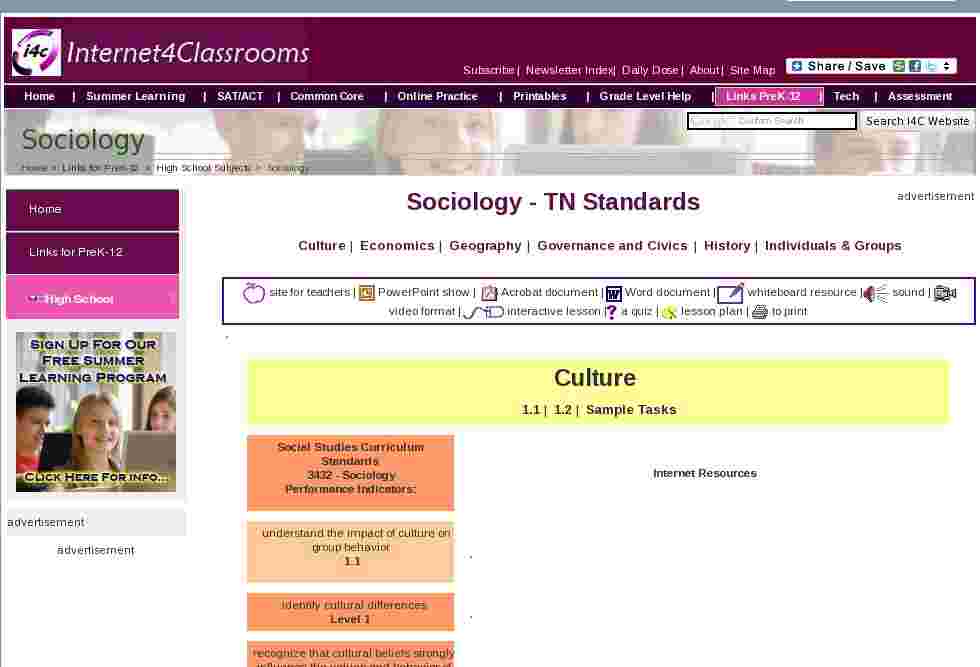advertisement
Sociology - TN Standards
Culture | Economics | Geography | Governance and Civics | History | Individuals & Groups
site for teachers |
PowerPoint show |
Acrobat document |
Word document |
whiteboard resource |
sound |
video format |
interactive lesson |
a quiz |
lesson plan |
to print
†
Social Studies Curriculum Standards
3432 - Sociology
Performance Indicators:†
Level 1†
Level 1†
Level 2†
Level 2†
Level 2†
Level 3†
Level 3† †
Level 1†
Level 1†
Level 2†
Level 2†
Level 2†
Level 2†
Level 2†
Level 3†
Level 3†
Level 3†
Rationale: Wedding ritual is primarily rooted in religion and expressed according to ethnicity, and it addresses sex, fertility, honor, loyalty, and other important facets of human social and family life. Weddings developed as religious actions, so they had to feature people the bride and groom whose righteousness could and had been publicly verified through a host of engagement rituals and family background checks. The ceremony itself was designed to publicly commit the bride and groom to their roles as upholders of religion and family.†
Social Studies Curriculum Standards
3432 - Sociology
Performance Indicators:†
Level 1†
Level 2†
Level 3† †
Level 1†
Level 2†
Level 3† †
Level 1†
Level 1† †
Level 1†
Level 2† †
Social Studies Curriculum Standards
3432 - Sociology
Performance Indicators:†
Level 1†
Level 2†
examine the effect of different geographical locations on cultural values
Level 2†
Level 3† †
Level 1†
Level 2†
Level 3†
Level 3† †
Social Studies Curriculum Standards
3432 - Sociology
Performance Indicators:†
Level 1†
Level 2†
Level 3† †
Level 1†
Level 2†
Level 2†
Level 3† †
Social Studies Curriculum Standards
3432 - Sociology
Performance Indicators:†
Level 1†
Level 2†
Level 3† This task will analyze the historical function of fairy tales and heroic stories in socialization.
Students will prepare a poster to compare one American fairy tale or heroic story with that of another culture such as Paul Bunyan, George Washington and the cherry tree, Legend of Sleepy Hollow, Mother Goose, Aesops Fables, Alexander the great, Mogli in the Jungle Book, King Arthur, etc. The student will summarize the tale for the class and show how his/her poster illustrates the moral or lesson learned (socialization). The students will compare how other cultures employed similar techniques to convey historic moral lessons.
†
Social Studies Curriculum Standards
3432 - Sociology
Performance Indicators:†
Level 1†
Level 2†
Level 2†
Level 3† †
Level 1†
Level 2†
Level 2†
Level 2†
Level 3† †
Level 1†
Level 2†
Level 2†
Level 2†
Level 3† †
Level 1†
Level 2†
Level 3† †
Level 1†
Level 2†
Level 2†
Level 3† †
Level 1†
Level 2†
Level 3†
Level 3† †
Level 1†
Level 1†
Level 2†
Level 2†
Level 2†
Level 2†
Level 3†
discuss stereotypes in society;
Level 3†
Level 3† †
Level 1†
Level 2†
Level 3†
Level 3† †
Level 1†
Level 1†
Level 2†
Level 3† †
Level 1†
Level 2†
Level 3† †

Search Internet4Classrooms
 Custom Search
Custom Search
- Site Map |
- About Us |
- Teacher Training |
- Make Internet4Classrooms.com your home page. |
- Copyright © 2000-2024 Internet4Classrooms, LLC All rights reserved.
Use of this Web site constitutes acceptance of our Terms of Service and Privacy Policy.
1764988071185834 US 18 desktop not tablet not iPad device-width